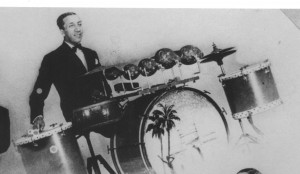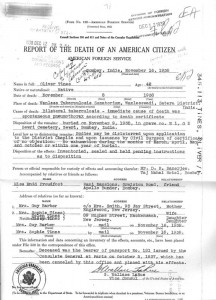In the mid-1930s, drummer Oliver Tines was a regular member of Louis Armstrong’s band. (That him, hazily in the background, back in 1933.) He was a part of the trumpet player’s Harlem Hot Rhythm outfit and toured Europe with Armstrong. His name can be found in the credits of at least a dozen jazz recordings made in the 1920s and ’30s. So how did he end up spending his last days back of the beyond in Satara, 256 kilometres south of Bombay?

By the time he died on November 16, 1938, Tines was pretty familiar with India. He’d visited in the country for the first time in September, 1935, as part of a band led by a violinist from Minnesota named Leon Abbey, to play the six-month winter season at the Taj Mahal Hotel. Abbey’s band sent Bombay’s upper-crust into a tizzy. Though the city had hosted foreign jazz outfits before, Abbey was special – he was the leader of the first “all negro” band ever to play in India.
In fact, Bombay was so taken with Abbey’s music, the Taj booked him to play the 1936 winter season too. So after a short vacation in Europe, Ollie Tines returned to Bombay in November 1936. He had some new band mates on this second trip, including the ace trumpet player Bill Coleman, who sketched a vivid account of the band’s stint in the city in his memoirs, Trumpet Story.
“We had seen many exiting things in the port towns we visited but Bombay gassed them all,” Coleman wrote. “There were so many sights that I almost had a sore neck turning it so much from the time we left the port until we reached the Taj Mahal Hotel.”
While most of the band members lived in apartments provided by the hotel, Tines and pianist Charles Lewis chose to move with “their Anglo-Indian girlfriends whom they had met during their first stay in Bombay”, Coleman said. The women, he added, were sisters.
After their second season at the Taj, Abbey’s band returned to Europe in April 1937. But Tines stayed behind. It isn’t clear why. The next time he appears in my research material is in November, 1938, in a document titled Report of The Death of An American Citizen, issued by the American Foreign Service. The document says that Tines died of bilaterial tuberculosis at the Wanless Tuberculosis Sanatorium in Wanlesswadi, Satara District on November 16, 1938. He was 42.
Along with the report, I found a sheaf of correspondence involving Oliver Tines’s wife, Sophie, who lived in Hackensack, New Jersey, his mother, Gertrude Barber, and American Foreign Service officials in the US and in Bombay, relating to the drummer’s personal effects. The officials told that Tines’s relatives that his baggage was in the possession of DR Banerjee, the Taj manager, but that there was no treaty with Great Britain that gave American officials in India the right to dispose of the effects of American citizens who died in their consular districts. Tines’s relatives were advised to contact Banerjee directly.
Eventually, Sophie Tines authorised the trumpet player Crickett Smith, who had performed alongside Tines at the Taj, to sell her late husband’s drum kit and send her the proceeds. She asked that his personal effects be given to “Miss Enid Proudfoot, Mani Mansion Ormiston Road, Apollo Bunder, Bombay, who cared for the deceased in his last illness”.
The report says that Tines had been buried in Bombay’s Sewri cemetery, in grave no N1, G2. One day not so long ago, I recruited my buddies Sidharth Bhatia and Vikram Doctor to accompany me on a visit to the burial site of a man who had played a significant role in helping Indians appreciate jazz. It took us a while to figure out how plots in the cemetery were numbered, but with the assistance of cemetery staff, we eventually found the section in which Tines’s grave was located. It turned out to be a bit of an anti-climax. The section, long unused, was complete overgrown. We pushed back a clump of tall weeds, but there was nothing to indicate a grave on the spot. Like many other graves in that section, Tines’s resting place wasn’t marked by a stone – probably because no one, not even Enid Proudfoot, cared to spend the money to commemorate the site.
In another twist, the records in the cemetery office state that the grave was actually sold to someone named James Logan in 1907, and there’s nothing to indicate that Tines was actually buried in it. That’s where the Oliver Tines trail turns cold.




16 comments
Fascinating!.
The Wanless Hospital is located in Wai which is at the foothills of the Mahableshwar Panchgani plateau. Many TB sanitaria in that area. Could he have been buried somwhere there?
Jehangir,
The report on Tines’s death is quite clear that he was buried in Bombay. I think that the grave is probably misidentified in the cemetery records. Or that he was buried in a grave owned by someone else. This will remain a mystery, I suppose.
Naresh
Excellent storytelling Naresh. And thanks for the clip.
Excellent Naresh. Waiting for the book now.
Yo Naresh. Fascinating as usual. Wonder what on earth he was doing in Satara. Unless he went to Panchgani to cool off, fell ill and was admitted to the Wanless Sanatorium at the foothills. I’m surmising that if he took ill in Mumbai he would have been taken to a hospice closer. Not as far as Satara. I wonder if the Sewrie cemetery was in the habit of creating space by interring the remains in a niche after a respectable passage of time. Which might explain why there is no sign of him. Wonder what happened to Enid. Cheers Bugs
Quite amazing. Admire the tenacity with which you pursued the trail. I imagine that you are in touch with Susheel Kurien and his ‘Finding Carlton’ project. Am I right? In any case, may the forensics continue! All the best!
Sanjay,
Many thanks. Yes, Susheel is a noble comrade and we’ve been swapping stories and research material…
Naresh
Very interesting read Naresh! Looking forward to the book coming out 🙂
great story, naresh. i read it with special interest because my family is from satara district — dad from rahimatpur, about 26 km from satara, and mom was born in wai, though she herself was a pune girl. 🙂 sharing this story and the blog, and waiting for the book. great work, congratulations!
a lady from Poona was is and always shall be a poona girl. She may be eighty but still a poona girl. Loving it. Fernandes you are truly the greatest. what work men. Tell me next time yr headed to Sewri Love the place. have ancestors there who are pushing up daisies
Great job Naresh..
Wonderfully written story Naresh, about this great drummer whom I admired so when I first heard/saw him in the vidclip above. Impeccable time and precision. As great as Louie was my eye goes to Oliver as he sits there effortlessly and makes the band cook. So happy to learn more about this very special drummer. Thank you! mb
Thanks so much, Michael.
Hello, many thanks for the superb research you’ve done. Please help me with information on trumpeter Charles “Charlie” Johnson’s last Indian tour with Abbey’s band, year and date? I’m doing research on Armstrong’s very important Scandinavian gigs. Johnson did the tour and he’s also visible in the Louis film shot in Copenhagen etc.
Very best wishes and friendly yours Per Oldaeus, Stockholm, Sweden.
Hi, Naresh I’d met you at the function at Green earth, going through Tines, burial record, if the grave record says N1, G2, N1 must be the “Niche” alloted after being buried in i.e G2, pr, i.e obably if its a borrowed burial site G2.
Just a guess
OLIVER TINES HAD CLASS… THANK YOU FOR THE INFO